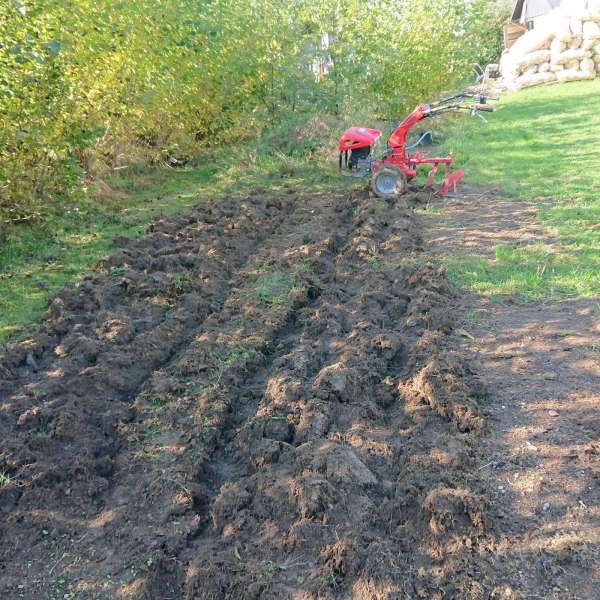There are 59 wild geese in this picture; they flew over my domicile due south this morning. I only snapped the picture with my phone; they move fast, and there wasn’t enough time to get my proper camera.
As far as I can tell, they really were heading dead southwards, not just approximately. I have a weather station, and I measured the orientation of my property several times. I know the north-south axis is slightly offset from my hedge. And subjectively, the path these followed was offset from my hedge at the same angle.
What do wild geese have to do with the title? Wild geese heading south mean autumn is here. And that means tilling the ground. In my garden, no till means usually no harvest. The soil is heavy clay, prone to self-compaction. Even local plants and grasses can struggle.
To help with the process of tilling the soil, I bought a small single-axis tractor ten years ago. Of all the labor-saving devices I’ve ever bought, this is the most controversial one – it cost me over 3,000 €, and it surely hasn’t saved me that much work yet. Mainly, because I am hesitant to use it. It sometimes has trouble starting after prolonged periods of non-use, which is frustrating. This year was no different; in fact, I could not start it at all for over a week.
I am not Otto McNick by any definition, so I was at a complete loss about what to do. The company that sold it to me and used to help in the past when the problem occurred no longer exists, and I could not find any service nearby. And I cannot take the device to a service further off, as it is too big. I contacted a lawn-mower service in a nearby town, but I got no reply. So I had no other option than to start studying the manual for the motor. I found nothing about the problem, except how to change the spark plug. So I did that.
It did not help; the machine still did not start. Then I remembered that the service mechanic said something about water condensate in the carburetor the last time this happened, so I started to search the internet about how to clean the carburetor. I found a short video, I watched it, and today in the morning, I crossed my fingers, then uncrossed them, and started disassembling the carburetor. I wiped the insides with a clean, dry paper towel, I blew every hole through with dry air, and I completely changed the fuel in the tank. Then I assembled everything back, hoping against hope that it worked – and voila, the machine started on the first pull of the cord!
If you haven’t had this experience, I cannot describe to you how good that feels. If you had, you know.
The tractor is not powerful enough to till established grass turf. That is why I planted my potatoes on top of the turf and covered them with soil and moss – to kill the grass, in the hopes that dead grass roots will be easier to till. It worked as expected, except I made one mistake – I left uncovered strips between the three potato patches, where the grass survived. Those did cause me some problems, I will know better next time – I will cover such walkpaths either with cardboard or with black cloth.
An acre is allegedly the amount of land that a man with a plough and a team of oxen can till in a day. It took me almost two hours to till these approximately 25 square meters, so I am woefully inadequate. Reasons for that are several – my tractor is nowhere near as powerful as a team of oxen, this was the first time the ground was being tilled in probably over a century, so I had to go over it three times in different directions, and it is small, thus I lost a lot of time turning around. One of the reasons why old-school farming was done on strips of land, not squares of land, was that once the oxen (tractor) were on a line, they could follow it for a reasonably long time.
History lesson aside, I will have to till my main patch too, I only wait to see if I get some late peas or not. Once the answer to that question is clear, I will start the machine again. Unfortunately, I know already that I won’t have spinach – the second crop either did not grow or bolted too, just like the first one. I probably have to add spinach to the list of crops that don’t do well here.
And lastly, a bit about the time and labor saving.
I hope this means I will be able to get consistent output out of this device in the future. Ploughing a garden patch with this tractor is no less laborious than tilling it with a spade, but it is about ten times quicker. I can do in a few hours work that would otherwise take me several days. If I can now start the device whenever I need it, I might finally get my money’s worth out of it.


























































